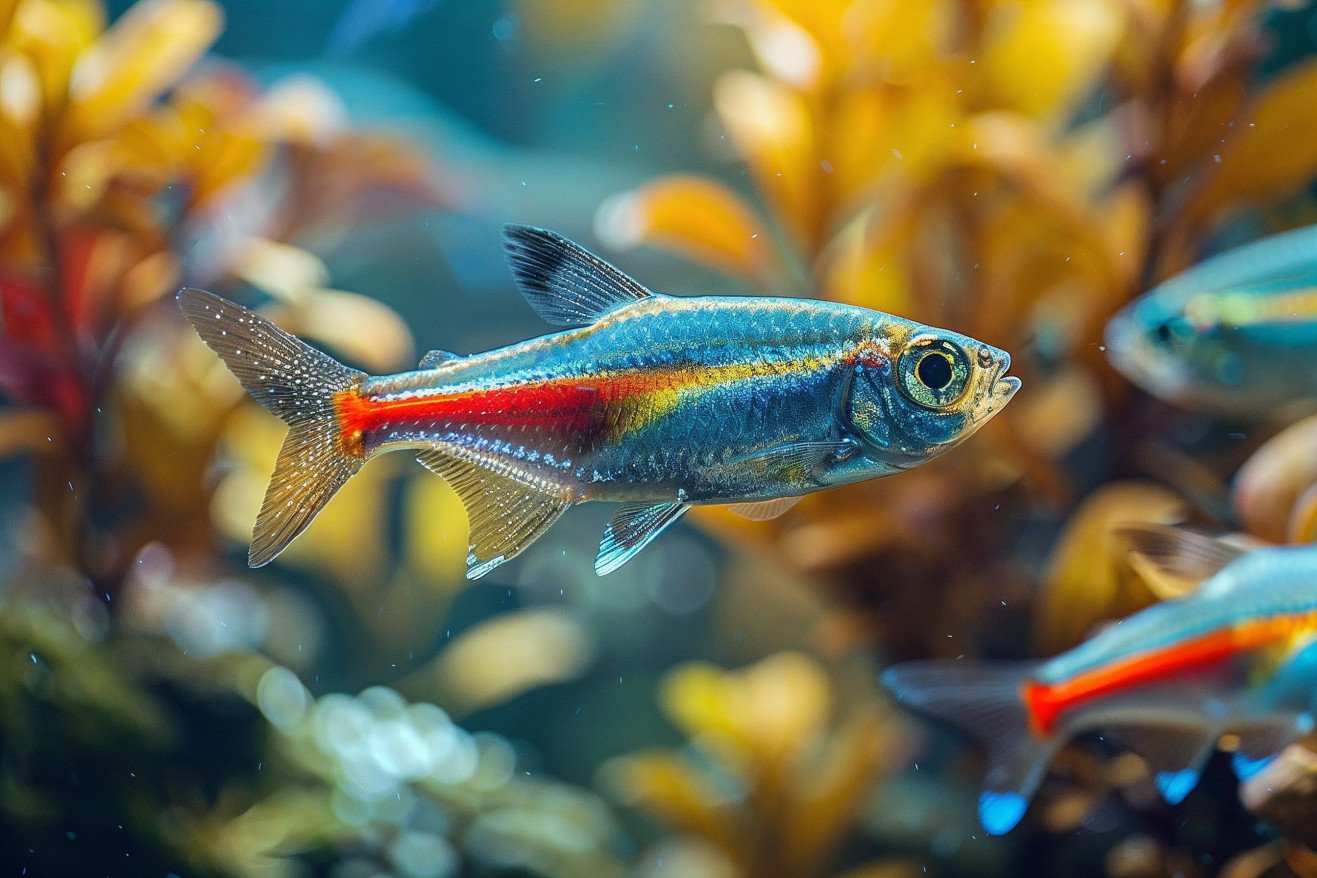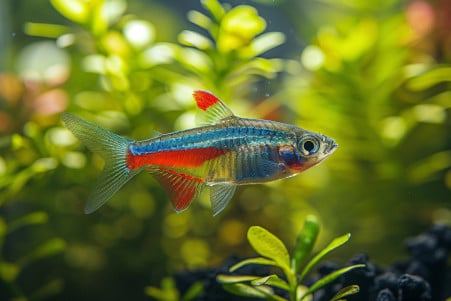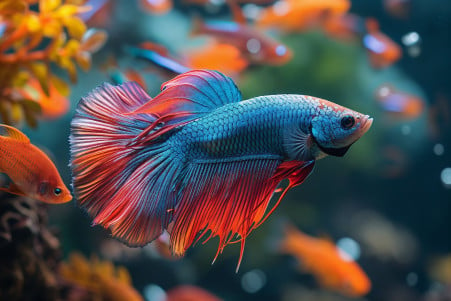Cardinal Tetra vs. Neon Tetra: What Are the Differences?
30 March 2024 • Updated 29 March 2024

Cardinal tetras and neon tetras are both small, brightly colored freshwater fish, but there are some important differences between these two popular aquarium fish. Cardinal tetras are a bit larger, have red and blue stripes that run the length of their bodies, and are native to Venezuela and Colombia, while neon tetras are smaller, have a horizontal neon blue stripe, and come from the rivers of Brazil, Colombia, and Peru.
To learn more about these South American tetras and decide which one is the best fit for your home aquarium, we'll look at information from reputable fishkeeping and ichthyology sources. We'll explore their distinct features, tank needs, breeding habits, and tankmate compatibility to help you understand how to set up an environment that will meet the specific needs of either the cardinal tetra or neon tetra.
What are the main differences between cardinal tetras and neon tetras?
Physical Characteristics: How to Tell the Cardinal Tetra and Neon Tetra Apart
Although the cardinal tetra and neon tetra have a similar body shape, there are some key differences that make it easy for aquarium enthusiasts to differentiate between the two. According to The Spruce Pets, the most noticeable difference is the length of the red stripe that runs along the side of the fish. In the cardinal tetra, the red stripe is long and extends from the eye to the tail. On the other hand, Modest Fish explains that the neon tetra has a shorter red stripe that only goes from the middle of the body to the tail.
In addition, eSHa Labs reports that the cardinal tetra is slightly larger, growing to an average adult size of about 4 cm (1.5 inches), while the neon tetra is smaller, growing to about 1 inch. It can be difficult to tell the difference between male and female tetras, but Modest Fish says that males have a small hook on their anal fin. Females are generally rounder and more bulbous, especially when they are carrying eggs.
Both the cardinal and neon tetras have a blue stripe that runs horizontally across their bodies, which contrasts with their red stripes. However, The Spruce Pets explains that the blue stripe on the cardinal tetra is often more metallic and shiny than the neon tetra's blue stripe, which is more neon in color. With their transparent fins and tails that fade to clear, both of these colorful tetras are sure to stand out in a freshwater tank.
Tank Size and Water Requirements
According to The Shrimp Farm, a minimum tank size of 20 gallons is suggested to ensure the best environment for both cardinal and neon tetras. Since these are schooling fish, it's recommended that they be kept in groups of at least 10 to ensure that they feel safe and secure in their environment and to encourage natural behaviors. Splashy Fish suggests that an additional 2 gallons of water should be added for each additional tetra.
The water parameters for these fish are also very specific. Cardinal tetras need very soft, acidic water with a pH of 4.5-7.5 and a hardness of less than 4 dGH, according to The Shrimp Farm. Neon tetras can handle a slightly higher pH level of 5-7, but they also need soft, acidic water. It's important to make sure that the water in the tank is cycled and stable to ensure that both fish remain healthy.
To mimic their natural environments, The Shrimp Farm suggests setting up a biotope-style tank with dark water that's been stained with tannins, low lighting, and lots of live plants, driftwood, and leaf litter for hiding places. It's also important to make sure that the water flow in the tank is gentle and the lighting is low to reduce stress, which is also noted by Splashy Fish.
Diet and Nutrition
Cardinal tetras and neon tetras are both omnivores, so they need a diverse diet to stay healthy. The Spruce Pets says that at least 75% of their diet should be made up of high-quality flake food to ensure that they get the vitamins and minerals they need. To round out their diet, Aquarium Tidings recommends feeding them frozen foods like bloodworms, brine shrimp, and daphnia, as well as some live foods.
When feeding, The Spruce Pets says that you should only give them as much food as they can eat in about five minutes, once or twice a day. Overfeeding can lead to water quality problems, so make sure to keep an eye on how much they're eating and adjust their portions accordingly. Although their dietary requirements are similar, The Shrimp Farm explains that cardinal tetras may need more vitamins in their diet than neon tetras.
It can take a while for newly introduced fish to get used to eating a captive diet, so make sure to watch their eating habits and make sure they're eating the food that you offer. By making sure that they get a mix of high-quality flake, frozen, and live foods, you can make sure that your cardinal tetras and neon tetras stay healthy and active for years to come.
Compatibility and Tank Mates
Both cardinal tetras and neon tetras are peaceful, community-oriented fish, so they can be kept with a variety of other freshwater species. According to Fishlab, cardinal tetras are "one of the mildest, most peaceable creatures you can have in a tank!" They are also small, growing to a maximum size of 2-3 inches, so they are unlikely to bother or eat other fish.
When choosing tank mates, Fishlab suggests picking fish that have similar water parameter requirements and feeding behaviors to avoid competition. Some compatible tank mates include kuhli loaches, dwarf gouramis, glass catfish, and harlequin rasboras. Aquarium Co-Op also says that neon tetras are great tank mates for cardinal tetras because their care requirements are almost identical.
It's also important to make sure that you keep both cardinal and neon tetras in groups of at least 6 to help minimize stress and encourage their natural shoaling behavior. The Spruce Pets warns that you should avoid keeping them with larger, more aggressive fish that may see them as food. However, if you choose tank mates carefully and make sure that their tank is set up properly, you can create a successful community tank for these peaceful South American tetras.
Health Issues and Disease Prevention
Cardinal tetras and neon tetras are both relatively hardy fish, but they are prone to a number of health issues, especially if their water quality and other environmental conditions are not properly maintained. One of the most serious health problems that affects both species is neon tetra disease, which is a degenerative disease caused by a parasite. As noted by The Spruce Pets, neon tetra disease is highly contagious and always fatal, so it's important to focus on prevention.
The parasite that causes neon tetra disease, Pleistophora hyphessobryconis, is transmitted when fish eat contaminated food or drink contaminated water. Aquarium Co-Op explains that it's important to buy fish from reputable sources, quarantine new fish, and maintain excellent water quality to prevent the introduction and spread of this disease. In addition, The Spruce Pets points out that cardinal tetras are more resistant to neon tetra disease than neon tetras.
Other health issues that affect both species include ich, fin rot, and bacterial infections. Aquarium Co-Op recommends keeping a close eye out for symptoms such as white spots, tattered fins, and lethargy and treating these issues with the appropriate medications as soon as they arise. Feeding the fish a varied diet and minimizing stress can also help keep their immune systems strong and prevent disease.
By quarantining new fish, maintaining excellent water quality, and feeding a varied diet, aquarium enthusiasts can help ensure that their cardinal tetras and neon tetras stay healthy in the long run. Buying fish from reputable sources and keeping a close eye on them for signs of disease are also important parts of maintaining a healthy aquarium community.
Breeding and Lifespan
Cardinal tetras are known to live 5-7 years in a home aquarium, while their neon tetra relatives have a lifespan of 3-5 years, according to Aquarium Co-Op. However, breeding cardinal tetras in captivity can be difficult because their water and behavioral needs are so different from what they are in the wild in the Amazon basin.
As explained by Wet Web Media, cardinal tetras need soft, acidic water with a pH below 6.5 and a temperature between 73-79°F. They are also very social and need to be kept in groups of at least 6. The right aquarium setup with lots of live plants is also important to provide hiding places and areas for the fish to spawn.
During the rainy season breeding period, TFH Magazine explains that cardinal tetras school in larger groups and become more active in the late afternoon before the sun goes down. To encourage this behavior in the aquarium, partial water changes and the introduction of live foods like brine shrimp may be necessary to encourage spawning. The fry also need to be cared for and monitored closely to ensure they survive.
In the end, while the longer lifespan and more vibrant coloration of the cardinal tetra make it a more attractive option for many aquarium enthusiasts than the neon tetra, the species' breeding needs are much more difficult to meet. However, acclimating the fish properly and providing the right environment will help ensure a healthy, long-lived population of these beautiful fish.
Conclusion: Which Tetra Is Right for Your Tank?
The cardinal tetra and neon tetra have many similarities, but it's important to understand their differences in physical appearance, water requirements, and behavior in order to provide the best care and ensure the long-term health and happiness of these fish in the aquarium.
For beginners, the neon tetra may be the best choice, as it's more tolerant of fluctuations in water quality. However, the cardinal tetra's longer lifespan of 5-8 years and stunning appearance may make it more attractive to experienced aquarists who are willing to meet its slightly more challenging care requirements.
No matter which species you choose, thorough research, expert advice, and careful observation of your fish will help you create a healthy, happy community in your tank. With the right conditions, these beautiful, peaceful tetras can bring the Amazon to your home and provide years of enjoyment.


